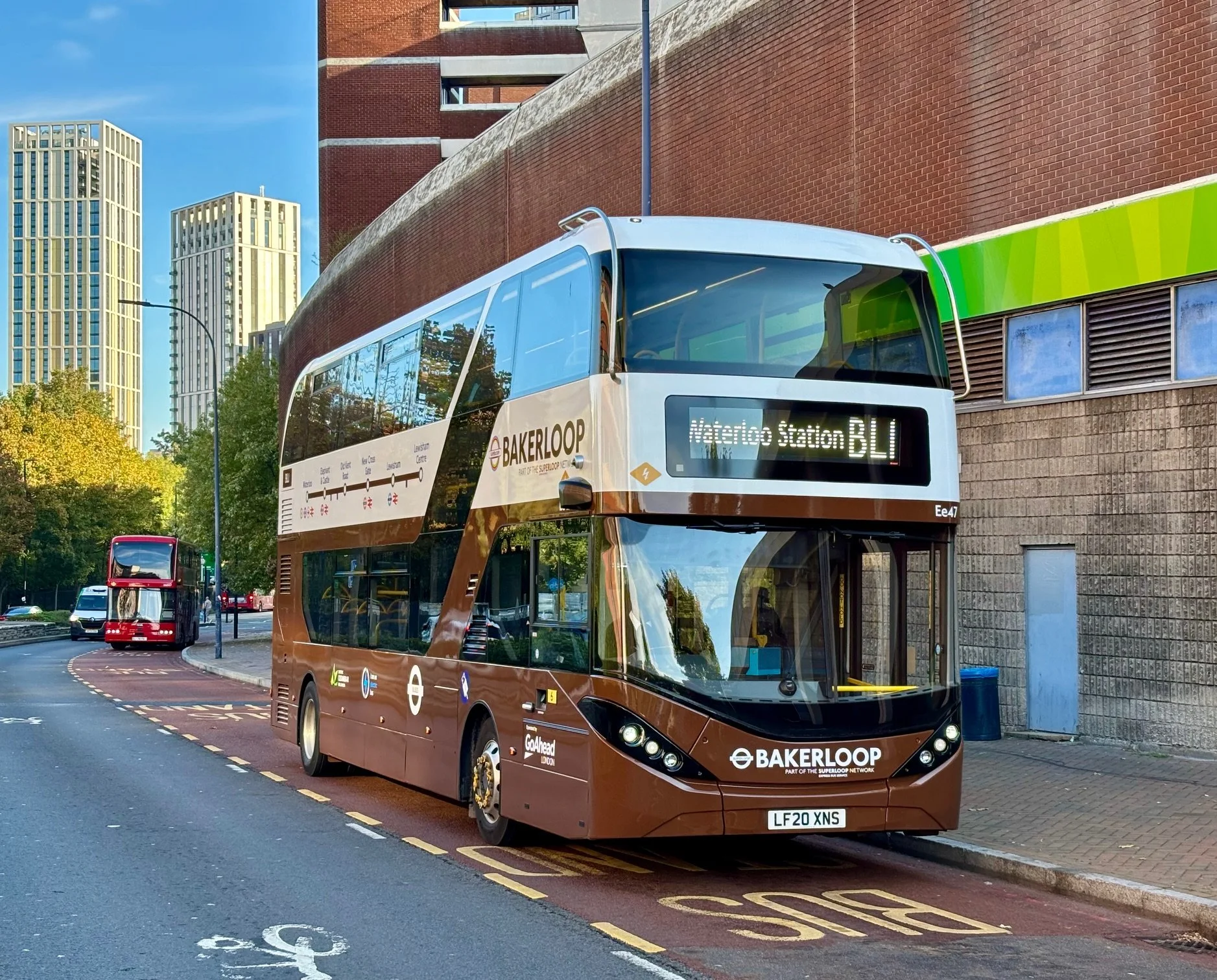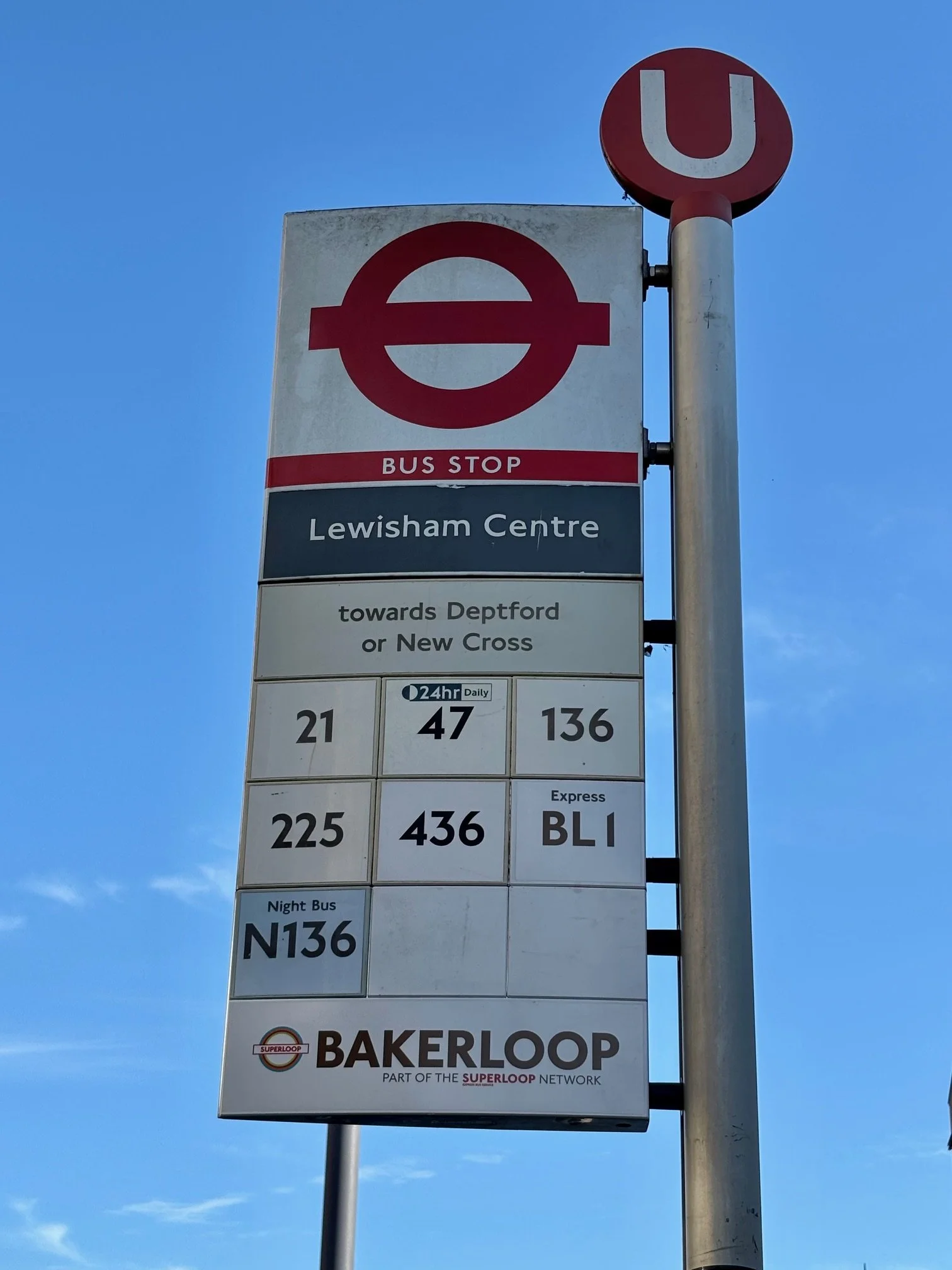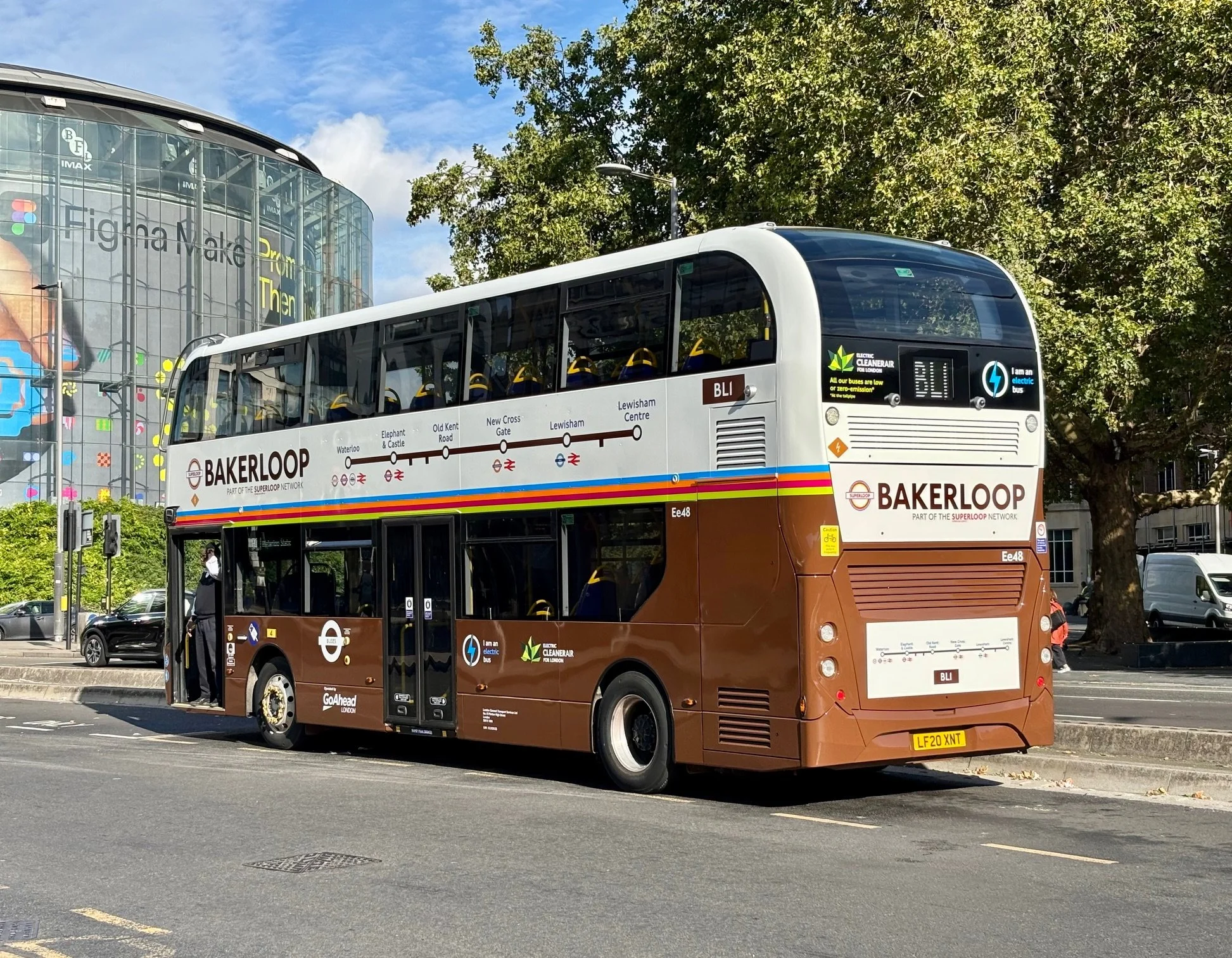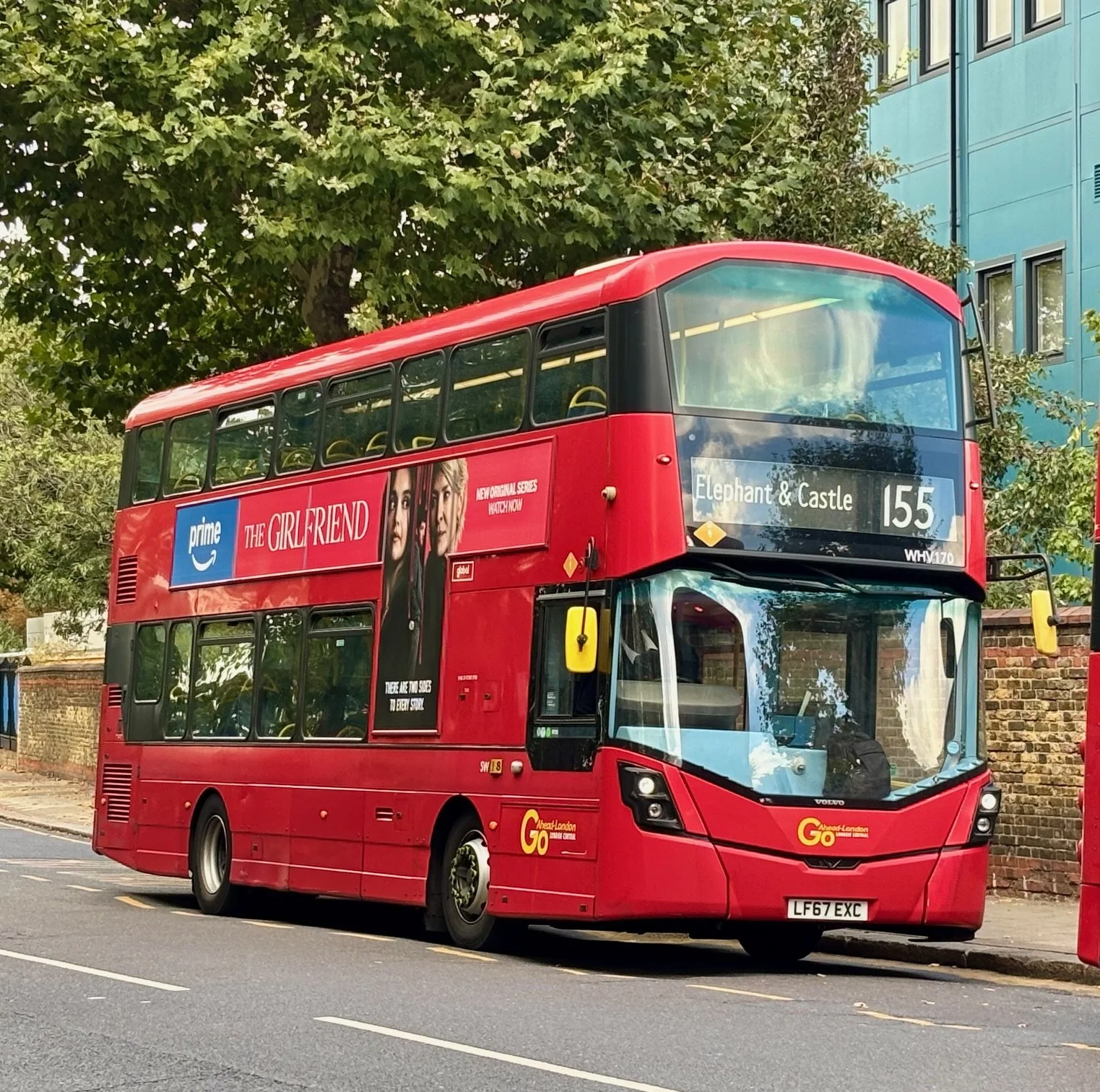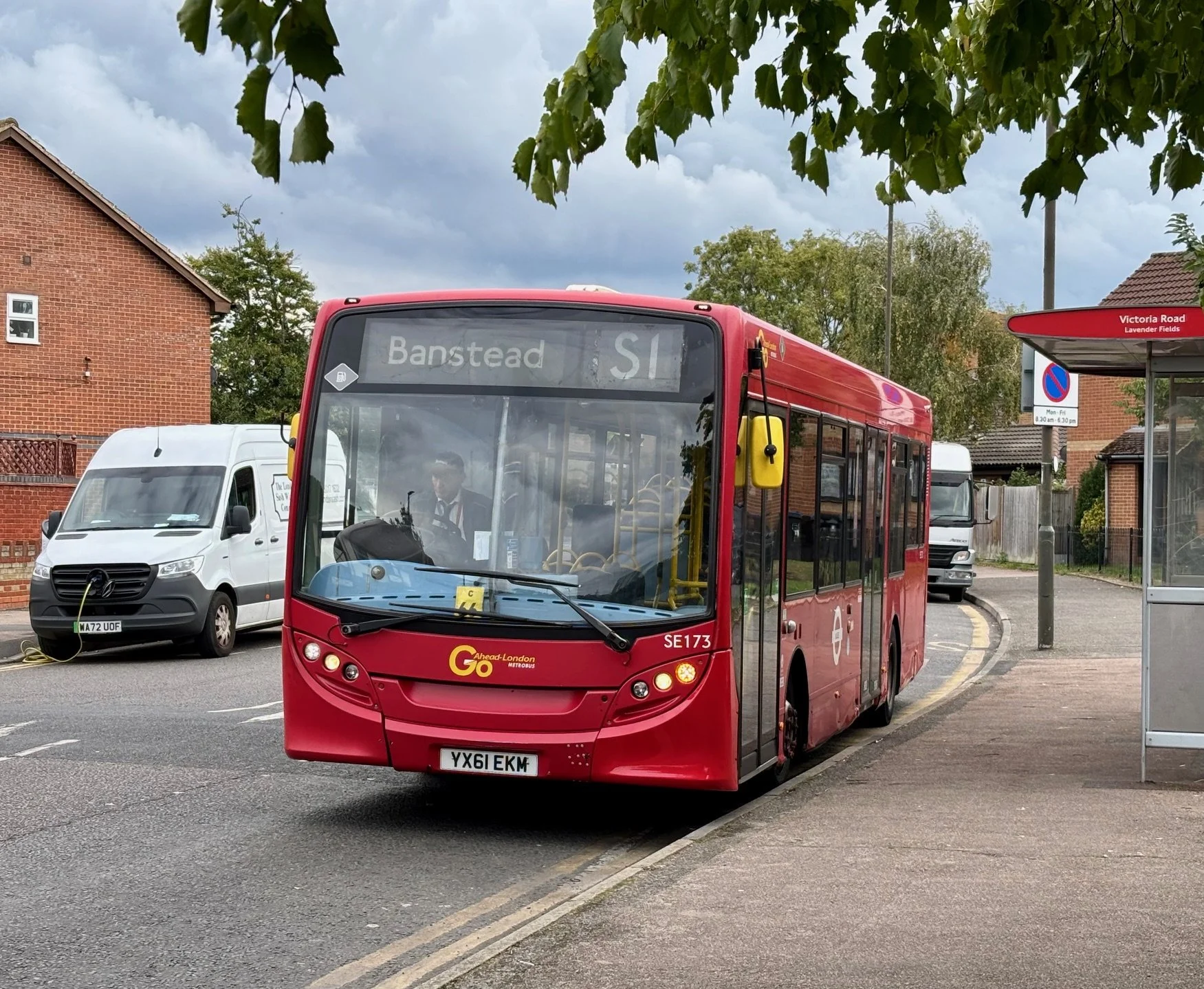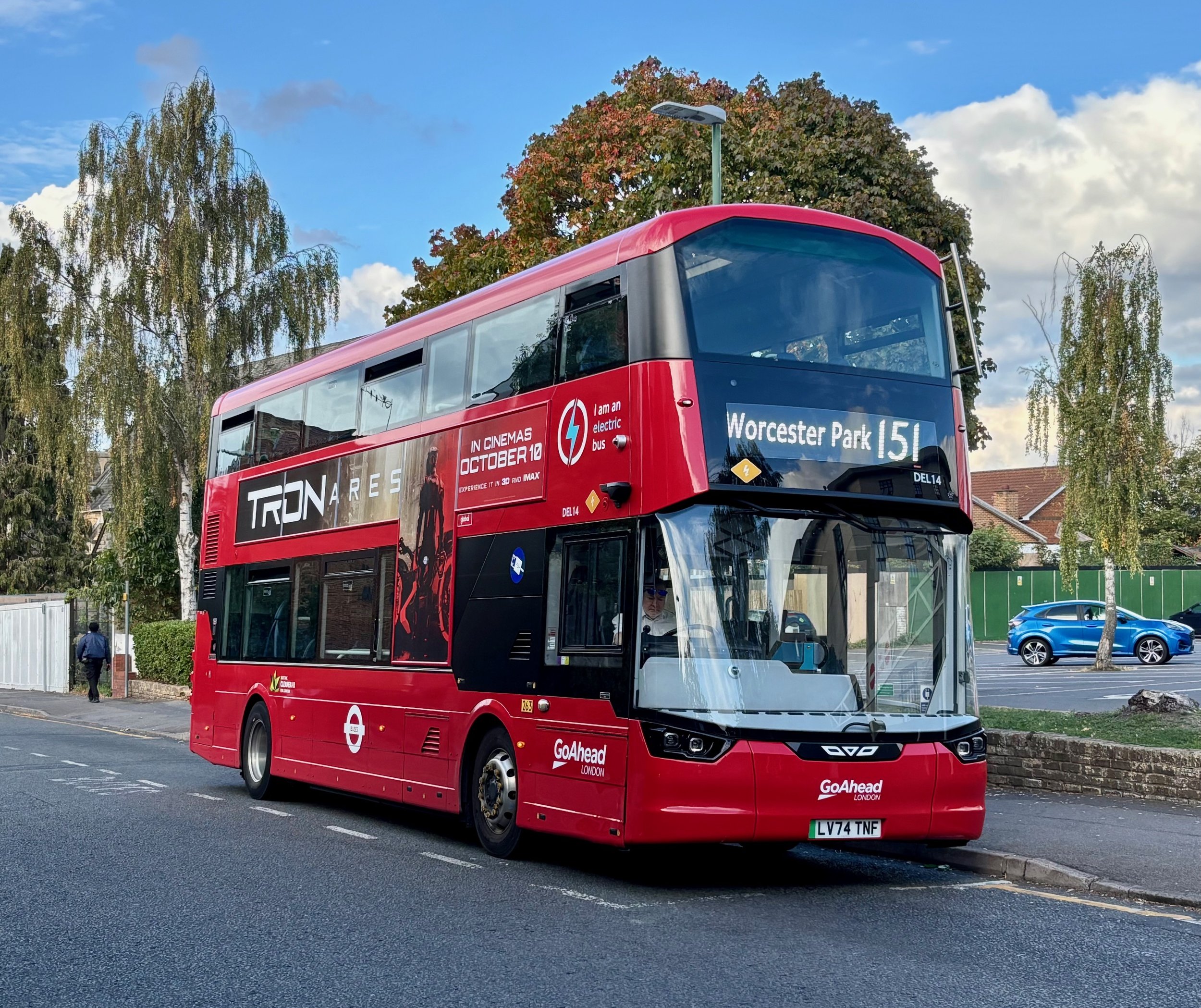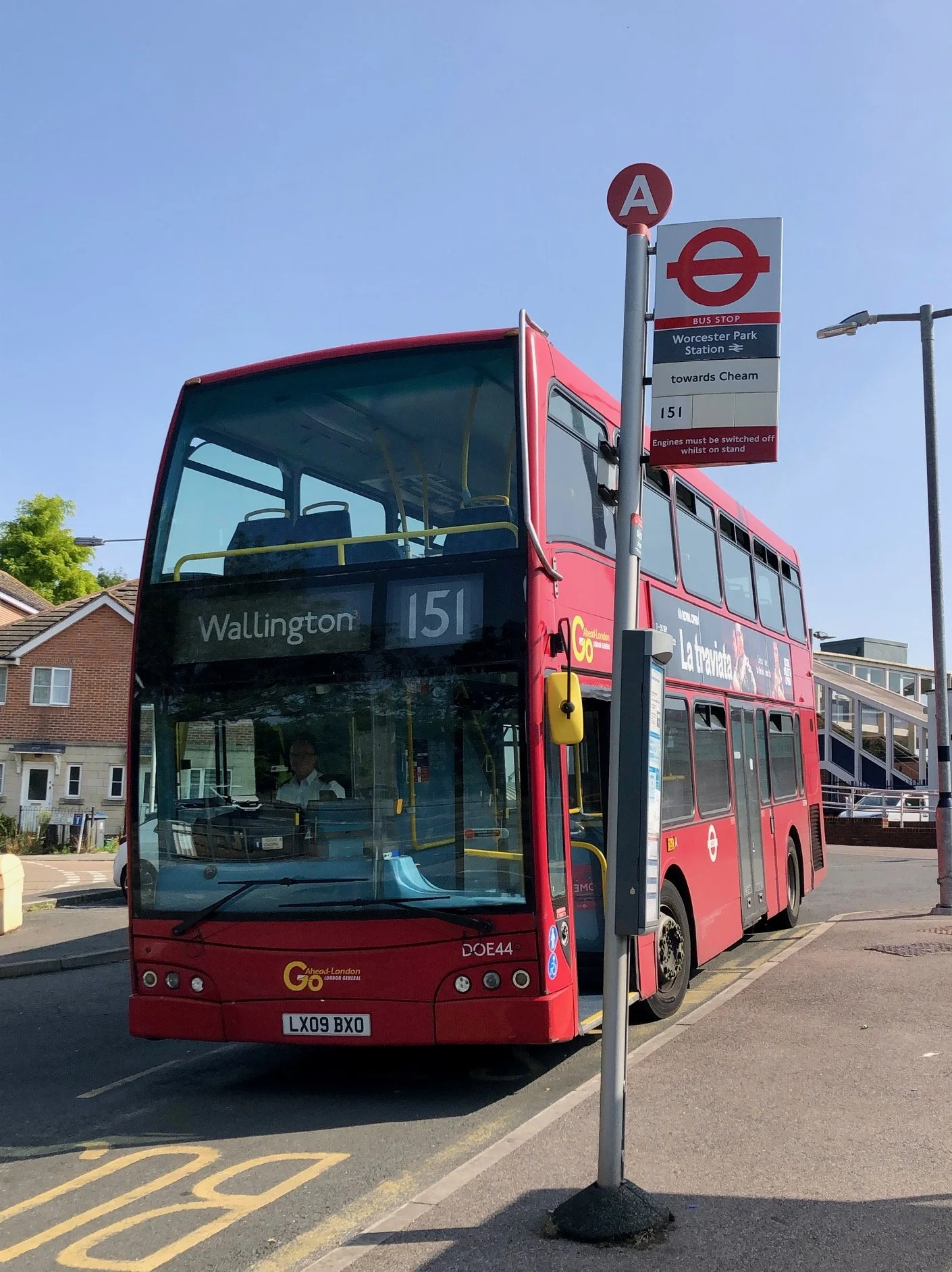From Bakerloop to Suttonloop
Back on the TfL bus rides this week, starting with a trip on the new “Bakerloop” BL1 on its first day and then taking another loop around the Sutton area on old and new vehicles.
Go Ahead London Enviro400 City EV Ee47 of Waterloo (RA) Garage at Lewisham Molesworth Street on Saturday 27th September 2025, the first day of new “Bakerloop” Route BL1.
This route is the precursor to the proposed extension of the Bakerloo Line from Elephant & Castle to Lewisham. It is intended to be “temporary”, but is likely to be around for at least 10 years based on current timescales!
Route BL1: Waterloo - Lewisham
Arriving at Waterloo Station by Underground around 08.30 on Saturday 27th September, my initial thought was that I was travelling on a train exactly 200 years after the first regular passenger railway opened between Stockton & Darlington in 1825! However, it was fitting that I was about to travel on the first day of another new service, this time the “Bakerloop” bus between Waterloo and Lewisham. This is an “express” service, marketed by TfL as part of the “Superloop” family, intended to stop at or near the proposed stations on the Bakerloo Line extension from Elephant & Castle to Lewisham. Due to protracted timescales on such major building projects, it is unlikely that the line will be open until at least 2035, so the bus will probably be around for a while.
Crossing Waterloo Road, I joined a small band of fellow enthusiasts who had the same idea as me at Stop D, the first pick up for the southbound BL1. The timetable showed a 12 min frequency M-S daytimes, 15 min eves & Suns, so we didn’t have long to wait before Go Ahead London Ee47 purred up to the stop, resplendent in its new chocolate livery with signwriting for the new route. The BL1 is operated out of Waterloo (RA) Garage, a natural choice for the allocation, given that the base has had few routes since the Red Arrow services were withdrawn. A slight surprise is that 12 existing electrics formerly at Northumberland Park (NP) Garage, which are 5 years old, have been refurbished and repainted for the service, rather than brand new vehicles being specified.
Boarding the bus, I was immediately struck by the Bakerloo Line style brown-based moquette with which the seats have been retrimmed. No fares are being charged for the first week to encourage usage, but passengers still have to tap in to be charged an amount of £0, presumably so that numbers can be monitored. Soon we were off and the express nature became apparent, as there are only 7 stops in total over the route in this direction.
Within 5 mins we were at Elephant & Castle, where there are 2 stops on either side of the roundabout, in London Road and on New Kent Road. Then, a fast run over the flyover at Bricklayers Arms, to the next stop at Old Kent Road Tesco. Proceeding down a largely empty Old Kent Road, we called at Ilderton Road only, before passing New Cross Garage and stopping at New Cross Gate Station. Another non-stop section into Lewisham, where we dropped off in Loampit Vale near the station, before terminating in Molesworth Street behind the Lewisham Centre. A creditable 32 min run, although this was 5 mins down on the schedule, despite minimal traffic and passengers just into double figures throughout.
The Bus Stops on the BL1 have brown “E” tiles for the route number and “Bakerloop” wording at the bottom.
Note the strapline “Part of the Superloop Network”. Superloop vinyls appear on the cab door inside the buses and Superloop signs on the top of bus shelters served.
BL1 Poster at Lewisham Centre Bus Stop describing the new route.
This is an experimental electronic screen with buttons at the bottom which can be pressed to show the next Live Arrivals on each route serving the stop, Posters describing route changes, Timetables for each route and General Information about TfL buses. Strangely, all in black and white.
Upper Deck interior of Ee48 at the start of my trip from Lewisham to Waterloo.
The new moquette in Bakerloo Line colours is apparent.
Route BL1: Lewisham - Waterloo
Walking around the corner to the front of the Lewisham Centre, I noted the Bus Stop flag with its brown “BL1 Express” E-tiles and “Bakerloop” legend underneath. An electronic panel beneath displayed a BL1 poster, timetable and minutes to next bus, if the appropriate buttons were pressed, together with equivalent information for other routes serving the stop.
For the return run, I had Ee48, similarly adorned to my previous bus, with a reasonable crowd boarding with me. Again, many were enthusiasts sampling a first day run, including a lady with her very young grandson who she said was mad on buses and excited to be on the first day of a new route! There is an extra stop on the return, as the BL1 calls at Lewisham Clock Tower and in Loampit Vale. Otherwise the stops are as in the opposite direction.
A busier journey, both in terms of passengers and traffic, meaning we took 37 mins for the trip back to Waterloo. Once again, this was 5 mins more than the schedule allowed, despite no significant delays. Nevertheless, certainly a much quicker trip than using other bus services. No doubt the BL1 will become a useful addition to the network.
Ee48 at Waterloo Station demonstrates the rear view of the “Bakerloop” livery on the first day of operation after my journey on it from Lewisham. The chocolate based scheme reflects the Bakerloo Line colour.
5 year old Ee38-49 formerly at Northumberland Park (NP) Garage have been refurbished and repainted for the BL1. Oddly, brand new buses were not specified.
Part Route BL1: Waterloo - Elephant & Castle
Having completed my “rounder”, I hopped on Ee39 for just one stop back from Waterloo to Elephant & Castle, where I alighted in London Road less than 5 mins later to continue my rides on other services.
Back to “normal” routes and GAL Volvo B5TL Wright Eclipse Gemini WHV170 of Stockwell (SW) Garage at St George’s Hospital Tooting on the 155.
This typifies the usual type on the route and was the bus I travelled on to this point from Elephant & Castle.
Route 155: Elephant & Castle - Tooting St George’s Hospital
My next ride was on was the 155, chosen because it provided a convenient link down to the Tooting area where I could hook up with the S1 on to Sutton & Banstead. Normal fare on the route, operated by Go Ahead London, comprises Wright Hybrid Volvos and I had WHV170 out of Stockwell (SW) Garage.
A few boarded with me at the Elephant, before we began our long straight run in parallel with the Northern Line through Inner London to the suburbs. Whilst the 155 is considered a trunk route, it is less busy than others on comparable radial corridors due to the faster Underground alternative for many journeys. Making our way along Kennington Road, we passed Kennington Station, with its unusual lead-covered domed roof which was typical of the City & South London Railway and not just a decorative feature but designed to hide the hydraulic lift winding gear when new in 1890.
Continuing on, we reached Oval Station, close to the nearby famous cricket ground which bears its name. Then on to Stockwell Station, which was rebuilt when the Victoria Line was extended through here to Brixton to provide interchange with the Northern Line. Making our way further south, we passed in turn Clapham North, Clapham Common and Clapham South Stations, the common providing a welcome splash of greenery along this mainly built up route. At Clapham South, the concrete structure marking the entrance to the former WW2 air raid shelter was visible on the edge of the common - sheltering up to 8,000 people during the War, it is now open for guided tours organised by the London Transport Museum on selected dates.
However, we trundled on through Balham, where a bomb fell on the Underground Station in 1940, sadly killing around 70 people sheltering there, which also involved a bus falling into the crater in the middle of the High Road, the photo of which became a powerful symbol of the London Blitz. We then arrived into Tooting, calling at Tooting Bec Station before joining a slow moving traffic queue down to Tooting Broadway, where almost everyone alighted. It was then just a few stops around the back streets to terminate at St George’s Hospital after a reasonable 50 min run.
The 155 began in 1951 as a replacement for Trams 2 & 4, from Wimbledon to the Embankment, operating in a loop via Blackfriars or Westminster in the same way as the trams had done. Initially, route numbers 155B or 155W were displayed depending on the direction of travel, but this was soon abandoned in favour of ultimate destinations “BLACKFRIARS & EMBANKMENT” or “WESTMINSTER & EMBANKMENT”. Begun with RTL operation, these were replaced with RTs by the end of the 50s. Over the years, the Embankment section withered away, the off-peak destination becoming Elephant & Castle, with the Embankment only served in M-F Peaks and early mornings by the 70s. At the other end of the route, there was a Sunday only extension to West Molesey / Hersham in the late 60s / early 70s, but the entire Sunday service was replaced by an extended 131 in 1973, leaving the 155 as M-S only.
RTs lingered on the 155 quite late in their lives, only being replaced by RMs in 1977. However, just before the end, I managed a trip by RT from Wimbledon around the Embankment during one afternoon rush hour. In 1984, the Embankment journeys were replaced by Aldwych as a destination, but this extension was withdrawn a year after OPO conversion to DMS in 1986, the route then going no further north than Elephant. In 1990, more tinkering saw the route diverted at Stockwell to Vauxhall, with Ms taking over from DMSs in the same year. A Sunday service was also restored at this time. Two years later, the route was converted to DW midibuses and withdrawn between Stockwell and Vauxhall. This unsuitable form of operation didn’t last though and double deck Ms returned in 1996, with a restoration of the route to Elephant once again.
Another single decking attempt came in 1999 with conversion to LDP Darts, together with the cut back at the southern end to Tooting St George’s Hospital, giving the route its current form. Since then, double decks have come back (again!) with PVL, WVL, E types performing, until the present hybrids took over in 2015.
Go Ahead London Enviro200 SE173 of Croydon (C) Garage arrives at Lavender Fields on the S1 before I rode it to Banstead.
These elderly buses replaced the OM class Optare Metrocities inherited from Quality Line, but not for long, as the S1 passes to Transport UK in November 2025.
Part Route 264: Tooting St George’s Hospital - Figge’s Marsh
At St George’s, I only had a short wait for Ee87 of GAL’s Croydon (C) Garage on the 264, for the 15min positioning journey on the 264 via Tooting Broadway, Amen Corner and Tooting Station to Figge’s Marsh, where I disembarked.
Route S1: Lavender Fields - Banstead
I then walked along Victoria Road a couple of stops to the Lavender Fields terminus of the S1. As the name suggests, there were once fields of lavender here, with Mitcham Lavender Oil being distilled and marketed in toiletries from the 18th Century onwards. Now, of course, the area is covered by housing.
Next bus to arrive was Go Ahead’s Enviro200 SE173 of Croydon (C) Garage, typical of the current offering on the route and the successor to the OM class Optare Metrocity types inherited from Quality Line when the contract passed over. However, the new order will be short-lived, as the service moves to Transport UK on re-tender in November. So, a final opportunity for me to sample the present vehicles.
We departed on schedule with half a dozen aboard, making our way back to the main road and then down into Mitcham Town Centre, where we had an exchange of passengers. Then on through the greenery of Mitcham Common, calling at the isolated Mitcham Junction Station. Passing close to Goat Road (GM) Garage, we made our way through the narrow back doubles via Mill Green to Green Wrythe Lane and suburban housing to Rose Hill Roundabout. Swinging a left, we served St Helier Hospital, before turning right over more back streets unique to this route, including a “hail & Ride” section, finally emerging at Sutton Green.
After traversing the various stops in Sutton Town Centre and calling at Sutton Station, we again left the main road to loop around more suburbia on a “Hail & Ride” basis, before joining up with other routes again at Sutton Hospital and The London Cancer Hub. We then crossed Downs Road in Belmont, for a speedy stretch across the wooded delights of Banstead Downs into Banstead itself, where we dropped off at various stops before finishing opposite M&S. 1h10m end to end.
The first incarnation of the S1 was as a circular from Stratford via East Ham from 1969-89, which began as a MBS Flat Fare route and progressed through DMS and T operation, before being replaced by changes to the 104 and 238.
Today’s S1 came in 1993 as a Sutton area midibus route between Beddington Corner & Sutton Station, operated by London & Country (later Londonlinks). Optare Metroriders were used initially. In 1996, the route passed to London General and was extended from Sutton to Banstead in lieu of a section of the 80, using Marshall Midibuses. Epsom Buses (trading as Quality Line), took the contract in 1997, initially with Metroriders but later with Mini Pointer Darts. 2000 saw an extension at the northern end to Hackbridge, but the following year saw a rerouteing to Mitcham Cricketers instead.
A further extension, to the current terminus at Lavender Fields, came in 2014, at which time Optare Metrocities took over. Quality Line operations were taken over by the RATP Group in 2017, but on closure of the depot in 2021, the route passed to GAL. 2022 saw some minor rerouteings in Belmont and St Helier, with SOE class vehicles joining the mix. Both the OM and SOE classes have since been replaced by elderly SEs, which will no doubt continue until the route passes to Transport UK.
My previous trip on the S1 back in Summer 2023 included a ride on Enviro200 Optare Esteem SOE6, then at GAL’s Goat Road (GM) Garage, seen on stand in Banstead.
This class is now extinct in TfL service.
Part Route S1: Banstead - Sutton
After a break for a late lunch, I resumed my rides by retracing my steps a short distance on the S1. This time, I had an even older bus, SE76, still with “BX” codes from its former home at Bexleyheath Garage. Last time I was here, over 2 years ago, I caught one of the few remaining SOEs in service, but these are now all gone, with the older Enviro200s likely to follow them soon.
A busy run, with plenty on and off throughout, apart from the fast stretch across the Downs. 20 mins later I alighted at Sutton Grove Road.
The new order on the 151 is represented by new Wright StreetDeck Electroliner DEL14 of Sutton (A) Garage, seen at Wallington Shotfield after my ride on it.
Whilst this type have been operating with Arriva and Stagecoach in London for a while now, these are the first of this class for GAL.
Route 151: Sutton - Worcester Park - Wallington
Final route of the day was the 151. This route has been one of several “lasts” for me, as I rode my last Sutton Garage PVL, WVL and DOE on the 151, the latter only last year. So, it made a change to chalk up a “first” on the route, with a ride on one of the new Wright StreetDeck Electroliners thereon. Originally, the plan was for the Enviro400 City EV types ordered for the rest of Sutton’s double deck routes to also appear on the 151, but they failed a route test, allegedly due to grounding issues on the slope at Worcester Park Station. Therefore, a batch of DOEs continued in service for a couple of years pending the arrival of the new DEL types.
I began with a ride from Sutton Town Centre to Worcester Park, with DEL14 being the next to appear. This type of bus is one I have ridden with Arriva and Stagecoach in London, but not before with Go Ahead, of which these were the first examples of the class to enter service, although now with more at other garages. The usual modern interior features were apparent, but oddly the bus was fitted with very narrow info-screens on each deck, showing just the next stop name in white out of blue above the route number in black out of white below. It seems every batch of new vehicles has a different configuration these days, a contrast with the standard displays of the original “i-bus”.
Nevertheless, a reasonably swift and quiet run out of Sutton, through Cheam Village and North Cheam, on to Worcester Park, where we terminated 20 mins later.
I had hoped to step-up a working, as there was another departure in front of us, but as this turned out to be a lone WHV on the route, I gave it a miss and awaited DEL14 once again, 12 mins later. There followed a fairly rapid run back through North Cheam and Cheam Village to Sutton, prompting me to assume that a driver change was in the offing! Sure enough, we arrived at Sutton Green, where the relevant announcement was played and we had a protracted changeover of about 5 mins. Once on the way again, we were caught in a queue past Rose Hill Park, where the circus was in town and traffic was turning in and out of the car park.
After this, we made better progress, almost circumnavigating Rose Hill Roundabout, before serving St Helier Hospital again and then making our way through the back doubles to Wrythe Green and Hackbridge Corner. We then powered past the delights of Beddington Park, before arriving into Wallington, terminating in Shotfield after exactly 1 hour from the start.
The 151 is now on its fourth incarnation as a London Bus Route, the previous versions being:
Hackbridge - Morden - Belmont (until 1970) RT operated at the end
Sutton - Carshalton Beeches - Belmont (Oct 1970 to April 1971 only) RF operated
Lewisham & Kidbrooke Ferrier Estate Circular (1972 to 1981) RT / RM / DMS operated in turn
The present version of the 151 began in 1984 between Wallington and Worcester Park, replacing a section of the 127 and offering support over part of the 213. There have been a couple of attempts to shorten the route, by cutting it back to either Cheam Village (2006-7) or North Cheam (2008-11), but vociferous complaints led to its reinstatement over its original full length. Always operated out of Sutton Garage, its principal types have been successively DMS, M, LDP, PVL, WVL, DOE and DEL, although other classes based at that shed have put in appearances.
As my bus rides were now over for the day, all that was left was to walk to nearby Wallington Station, to catch the Southern service to Victoria and thence home.
Watton
And Finally…
A reminder of the old order on the 151, where we see Enviro400 Optare Olympus DOE 44 of Sutton (A) Garage at Worcester Park Station in Summer 2024.
Whilst these vehicles are now all withdrawn from TfL service, many have been cascaded to other Go Ahead companies for further use.

